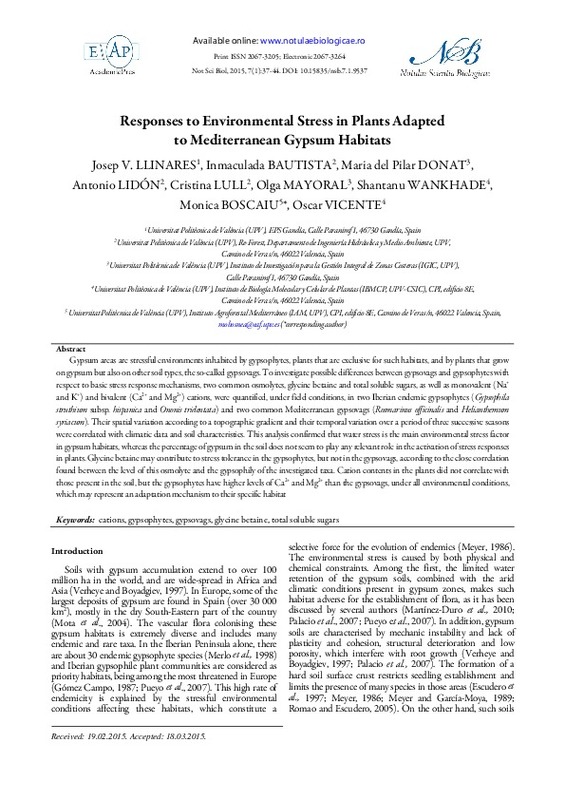JavaScript is disabled for your browser. Some features of this site may not work without it.
Buscar en RiuNet
Listar
Mi cuenta
Estadísticas
Ayuda RiuNet
Admin. UPV
Responses to environmental stress in plants adapted to Mediterranean gypsum habitats
Mostrar el registro sencillo del ítem
Ficheros en el ítem
| dc.contributor.author | Llinares Palacios, Josep Vicent
|
es_ES |
| dc.contributor.author | Bautista Carrascosa, Inmaculada
|
es_ES |
| dc.contributor.author | Donat-Torres, María P.
|
es_ES |
| dc.contributor.author | Lidón, A.
|
es_ES |
| dc.contributor.author | Lull Noguera, Cristina
|
es_ES |
| dc.contributor.author | Mayoral García-Berlanga, Olga
|
es_ES |
| dc.contributor.author | Wankhade, Shantanu Devidas
|
es_ES |
| dc.contributor.author | Boscaiu, Mónica
|
es_ES |
| dc.contributor.author | Vicente, Óscar
|
es_ES |
| dc.date.accessioned | 2016-03-14T14:18:13Z | |
| dc.date.available | 2016-03-14T14:18:13Z | |
| dc.date.issued | 2015 | |
| dc.identifier.issn | 2067-3205 | |
| dc.identifier.uri | http://hdl.handle.net/10251/61836 | |
| dc.description.abstract | [EN] Gypsum areas are stressful environments inhabited by gypsophytes, plants that are exclusive for such habitats, and by plants that grow on gypsum but also on other soil types, the so-called gypsovags. To investigate possible differences between gypsovags and gypsophytes with respect to basic stress response mechanisms, two common osmolytes, glycine betaine and total soluble sugars, as well as monovalent (Na+ and K+) and bivalent (Ca2+ and Mg2+) cations, were quantified, under field conditions, in two Iberian endemic gypsophytes (Gypsophila struthium subsp. hispanica and Ononis tridentata) and two common Mediterranean gypsovags (Rosmarinus officinalis and Helianthemum syriacum). Their spatial variation according to a topographic gradient and their temporal variation over a period of three successive seasons were correlated with climatic data and soil characteristics. This analysis confirmed that water stress is the main environmental stress factor in gypsum habitats, whereas the percentage of gypsum in the soil does not seem to play any relevant role in the activation of stress responses in plants. Glycine betaine may contribute to stress tolerance in the gypsophytes, but not in the gypsovags, according to the close correlation found between the level of this osmolyte and the gypsophily of the investigated taxa. Cation contents in the plants did not correlate with those present in the soil, but the gypsophytes have higher levels of Ca2+ and Mg2+ than the gypsovags, under all environmental conditions, which may represent an adaptation mechanism to their specific habitat, | es_ES |
| dc.description.sponsorship | This work has been supported by the Spanish Ministry of Science and Innovation (Project CGL2008-00438/BOS), with contribution from the European Regional Development Fund. | |
| dc.language | Inglés | es_ES |
| dc.publisher | Academic Press | es_ES |
| dc.relation.ispartof | Notulae Scientia Biologicae | es_ES |
| dc.rights | Reconocimiento (by) | es_ES |
| dc.subject | Cations | es_ES |
| dc.subject | Gypsophytes | es_ES |
| dc.subject | Gypsovags | es_ES |
| dc.subject | Glycine betaine | es_ES |
| dc.subject | Total soluble sugars | es_ES |
| dc.subject.classification | BOTANICA | es_ES |
| dc.subject.classification | BIOLOGIA VEGETAL | es_ES |
| dc.subject.classification | EDAFOLOGIA Y QUIMICA AGRICOLA | es_ES |
| dc.subject.classification | BIOQUIMICA Y BIOLOGIA MOLECULAR | es_ES |
| dc.title | Responses to environmental stress in plants adapted to Mediterranean gypsum habitats | es_ES |
| dc.type | Artículo | es_ES |
| dc.identifier.doi | 10.15835/nsb.7.1.9537 | |
| dc.relation.projectID | info:eu-repo/grantAgreement/MICINN//CGL2008-00438/ES/RESPUESTAS DE LAS PLANTAS AL ESTRES ABIOTICO: CORRELACION CON LAS CARACTERISTICAS EDAFICAS DE SUS HABITATS NATURALES/ | es_ES |
| dc.rights.accessRights | Abierto | es_ES |
| dc.contributor.affiliation | Universitat Politècnica de València. Instituto de Investigación para la Gestión Integral de Zonas Costeras - Institut d'Investigació per a la Gestió Integral de Zones Costaneres | es_ES |
| dc.contributor.affiliation | Universitat Politècnica de València. Departamento de Química - Departament de Química | es_ES |
| dc.contributor.affiliation | Universitat Politècnica de València. Departamento de Ecosistemas Agroforestales - Departament d'Ecosistemes Agroforestals | es_ES |
| dc.contributor.affiliation | Universitat Politècnica de València. Departamento de Biotecnología - Departament de Biotecnologia | es_ES |
| dc.contributor.affiliation | Universitat Politècnica de València. Instituto Agroforestal Mediterráneo - Institut Agroforestal Mediterrani | es_ES |
| dc.contributor.affiliation | Universitat Politècnica de València. Instituto Universitario Mixto de Biología Molecular y Celular de Plantas - Institut Universitari Mixt de Biologia Molecular i Cel·lular de Plantes | es_ES |
| dc.contributor.affiliation | Universitat Politècnica de València. Departamento de Ingeniería Hidráulica y Medio Ambiente - Departament d'Enginyeria Hidràulica i Medi Ambient | es_ES |
| dc.description.bibliographicCitation | Llinares Palacios, JV.; Bautista Carrascosa, I.; Donat-Torres, MP.; Lidón, A.; Lull Noguera, C.; Mayoral García-Berlanga, O.; Wankhade, SD.... (2015). Responses to environmental stress in plants adapted to Mediterranean gypsum habitats. Notulae Scientia Biologicae. 7(1):37-44. https://doi.org/10.15835/nsb.7.1.9537 | es_ES |
| dc.description.accrualMethod | S | es_ES |
| dc.relation.publisherversion | http://dx.doi.org/10.15835/nsb.7.1.9537 | es_ES |
| dc.description.upvformatpinicio | 37 | es_ES |
| dc.description.upvformatpfin | 44 | es_ES |
| dc.type.version | info:eu-repo/semantics/publishedVersion | es_ES |
| dc.description.volume | 7 | es_ES |
| dc.description.issue | 1 | es_ES |
| dc.relation.senia | 294517 | es_ES |
| dc.identifier.eissn | 2067-3264 | |
| dc.contributor.funder | Ministerio de Ciencia e Innovación |








